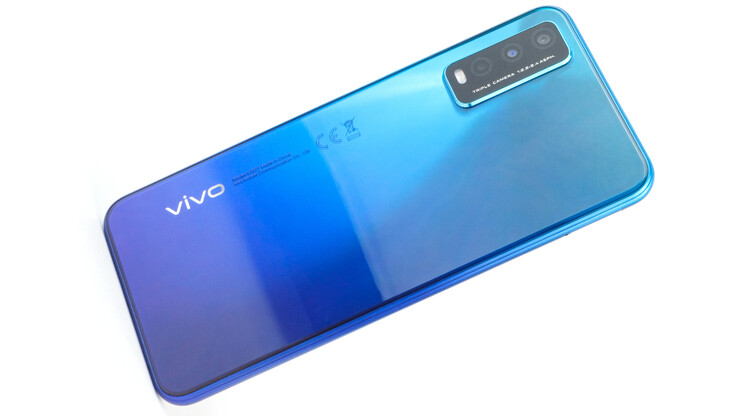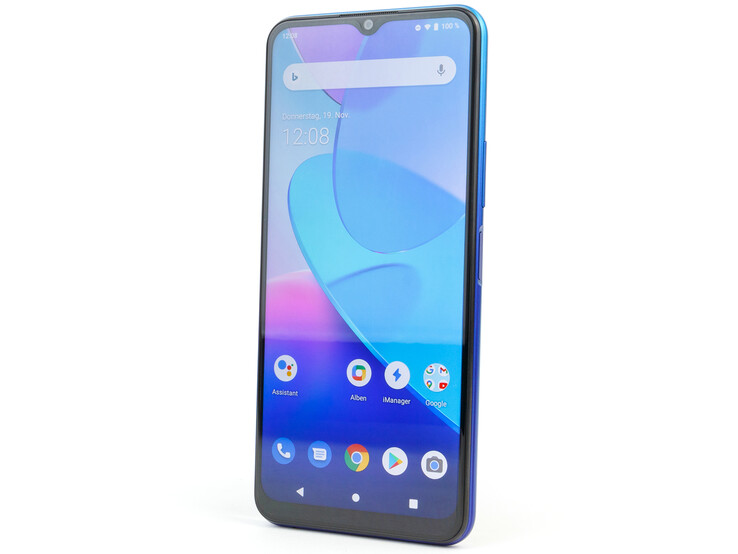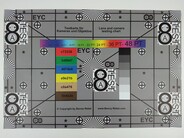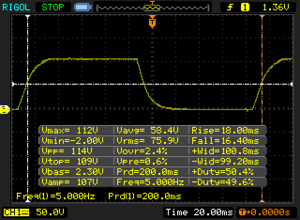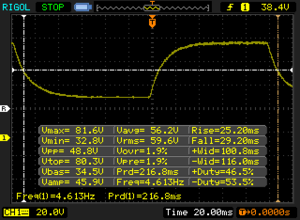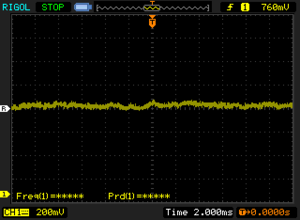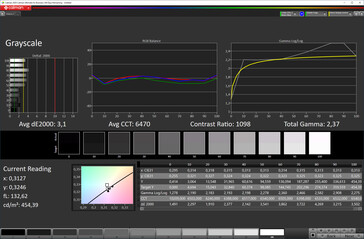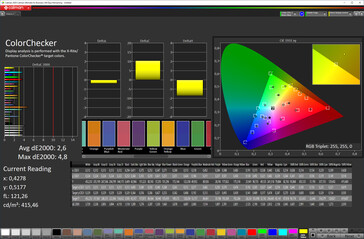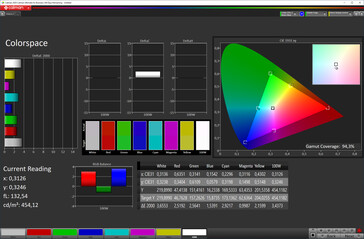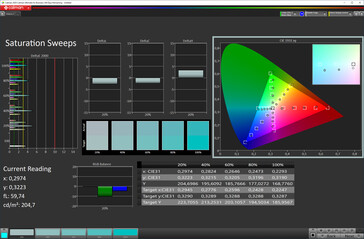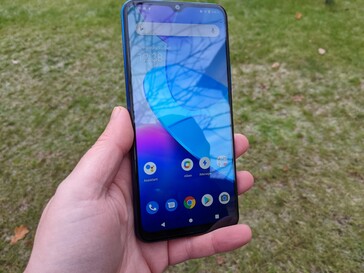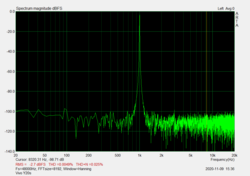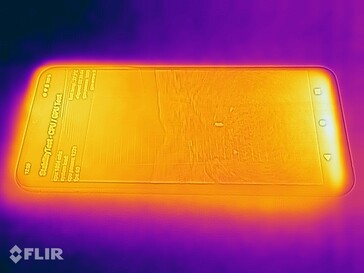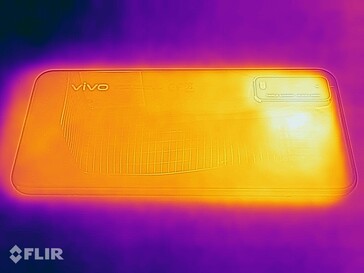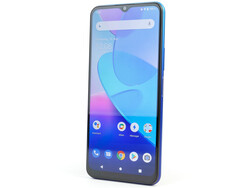Vivo Y20s Review - Slim entry-level smartphone with thick battery
Possible competitors in comparison
Bewertung | Rating Version | Datum | Modell | Gewicht | Laufwerk | Groesse | Aufloesung | Preis ab |
|---|---|---|---|---|---|---|---|---|
| 77.1 % v7 (old) | v7 (old) | 01 / 2021 | Vivo Y20s SD 460, Adreno 610 | 192.3 g | 128 GB UFS 2.0 Flash | 6.51" | 1600x720 | |
| 77.8 % v7 (old) | v7 (old) | 09 / 2020 | Xiaomi Redmi 9 Helio G80, Mali-G52 MP2 | 198 g | 32 GB eMMC Flash | 6.53" | 2340x1080 | |
| 79.2 % v7 (old) | v7 (old) | 11 / 2019 | Samsung Galaxy A30s Exynos 7904, Mali-G71 MP2 | 166 g | 64 GB eMMC Flash | 6.40" | 1560x720 | |
| 78.6 % v7 (old) | v7 (old) | 11 / 2020 | ZTE Blade V2020 Helio P70, Mali-G72 MP3 | 185 g | 128 GB eMMC Flash | 6.53" | 2340x1080 |
Case, equipment and operation
The Vivo Y20s is available in the color variants Obsidian Black and Nebula Blue, the latter of which is our test device. The smartphone is mainly made of plastic and is well manufactured. The gaps are tight and even. Only firm pressure on the display provokes a slight ripple.
The equipment is on a typical class level. Only the microUSB port looks a bit old-fashioned, but it supports OTG. The micro-SD card slot does not support the exFAT file system and an NFC chip is not installed either. In return, the Vivo smartphone is DRM-certified and can also play protected content in HD.
Our review sample was still shipped with Google Android 10, but the update to Android 11 was already rolled out during the test. Vivo also promises software support and security updates for four years for the Y20s - exemplary and anything but self-evident in this price range.
The Vivo Y20s can access the data network via LTE at best. The supported frequency bands are wider than necessary in this country, but that does not make the smartphone a globetrotter. The reception performance was inconspicuous in the test. The Wi-Fi module uses Wi-Fi 5 and convinces with a decent speed and stable data transmission to our reference router Netgear Nighthawk AX12.
The voice quality of the Vivo smartphone is good. When held to the ear, the user is transmitted clearly and understandably. Those who use the speaker are rendered with an audible reverb, which is occasionally joined by a quiet hum. The noise suppression reaches its limits in loud noises and muffles them, but also the Y20s user's voice, which then sounds mechanical and slightly choppy. However, quieter noises are not a problem. The smartphone also supports VoLTE, Wi-Fi calling and full dual-SIM.
A fingerprint scanner is integrated into the side power button for biometric security. The recognition rate is excellent and the user is directly guided to the home screen or the still open app by a short tap. Alternatively, 2D facial recognition is available, but it is less secure
| Networking | |
| iperf3 transmit AX12 | |
| Xiaomi Redmi 9 | |
| ZTE Blade V2020 | |
| Vivo Y20s | |
| Samsung Galaxy A30s | |
| iperf3 receive AX12 | |
| Vivo Y20s | |
| ZTE Blade V2020 | |
| Xiaomi Redmi 9 | |
| Samsung Galaxy A30s | |
Cameras - triple optics for the Vivo Y20s
Pictures taken with the front-facing camera of the Vivo Y20s are quite good. Besides the main camera, the triple camera on the back has two additional cameras with 2 MP each, which are responsible for bokeh effects or close-ups and hardly offer any added value
The main camera takes decent pictures in daylight, but they are not very dynamic and do not cope well with backlight. The zoom is limited to a 4x digital magnification and delivers a weak quality. Videos can be recorded in 1,080p (30 FPS) on both sides
Image comparison
Choose a scene and navigate within the first image. One click changes the position on touchscreens. One click on the zoomed-in image opens the original in a new window. The first image shows the scaled photograph of the test device.
WeitwinkelWeitwinkelZoom (4/5-fach)Low-Light

Display - Y20s with flicker-free IPS panel
The Vivo Y20s has a 6.51-inch (16.54 cm) IPS display that only works with the small HD resolution and thus pixel structures are definitely visible in fine details. The brightness is on a class-standard level and can also be fully accessed in manual mode. However, the APL50 measurements reveal weaker results in both peak brightness and black level (max. 407 cd/m², black level: 0.45 cd/m²), so the contrast ratio drops to 904:1 in this case
The panel's color reproduction determined with CalMAN is quite natural when the color temperature is manually adjusted (see screenshot), otherwise the display is a bit cooler. Outdoors, the Y20s is well legible on cloudy days
| |||||||||||||||||||||||||
Brightness Distribution: 87 %
Center on Battery: 502 cd/m²
Contrast: 1224:1 (Black: 0.41 cd/m²)
ΔE ColorChecker Calman: 2.6 | ∀{0.5-29.43 Ø4.78}
ΔE Greyscale Calman: 3.1 | ∀{0.09-98 Ø5}
94.3% sRGB (Calman 2D)
Gamma: 2.37
CCT: 6470 K
| Vivo Y20s IPS, 1600x720, 6.5" | Xiaomi Redmi 9 IPS LCD, 2340x1080, 6.5" | Samsung Galaxy A30s Super AMOLED, 1560x720, 6.4" | ZTE Blade V2020 IPS, 2340x1080, 6.5" | |
|---|---|---|---|---|
| Response Times | 23% | 91% | 29% | |
| Response Time Grey 50% / Grey 80% * (ms) | 54.4 ? | 46 ? 15% | 4 ? 93% | 44.4 ? 18% |
| Response Time Black / White * (ms) | 34.4 ? | 24 ? 30% | 4 ? 88% | 20.8 ? 40% |
| PWM Frequency (Hz) | 500 ? | 240.4 ? | 63290 ? | |
| Screen | -25% | 18% | -26% | |
| Brightness middle (cd/m²) | 502 | 476 -5% | 488 -3% | 465 -7% |
| Brightness (cd/m²) | 468 | 436 -7% | 489 4% | 474 1% |
| Brightness Distribution (%) | 87 | 86 -1% | 93 7% | 92 6% |
| Black Level * (cd/m²) | 0.41 | 0.67 -63% | 0.26 37% | |
| Contrast (:1) | 1224 | 710 -42% | 1788 46% | |
| Colorchecker dE 2000 * | 2.6 | 3.51 -35% | 1.7 35% | 5.3 -104% |
| Colorchecker dE 2000 max. * | 4.8 | 9.38 -95% | 3.3 31% | 9.9 -106% |
| Greyscale dE 2000 * | 3.1 | 1.5 52% | 2 35% | 5.5 -77% |
| Gamma | 2.37 93% | 2.166 102% | 2.1 105% | 2.19 100% |
| CCT | 6470 100% | 6485 100% | 6506 100% | 7659 85% |
| Total Average (Program / Settings) | -1% /
-15% | 55% /
36% | 2% /
-15% |
* ... smaller is better
Display Response Times
| ↔ Response Time Black to White | ||
|---|---|---|
| 34.4 ms ... rise ↗ and fall ↘ combined | ↗ 18 ms rise | |
| ↘ 16.4 ms fall | ||
| The screen shows slow response rates in our tests and will be unsatisfactory for gamers. In comparison, all tested devices range from 0.1 (minimum) to 240 (maximum) ms. » 92 % of all devices are better. This means that the measured response time is worse than the average of all tested devices (20.2 ms). | ||
| ↔ Response Time 50% Grey to 80% Grey | ||
| 54.4 ms ... rise ↗ and fall ↘ combined | ↗ 25.2 ms rise | |
| ↘ 29.2 ms fall | ||
| The screen shows slow response rates in our tests and will be unsatisfactory for gamers. In comparison, all tested devices range from 0.165 (minimum) to 636 (maximum) ms. » 91 % of all devices are better. This means that the measured response time is worse than the average of all tested devices (31.6 ms). | ||
Screen Flickering / PWM (Pulse-Width Modulation)
| Screen flickering / PWM not detected | |||
In comparison: 53 % of all tested devices do not use PWM to dim the display. If PWM was detected, an average of 8101 (minimum: 5 - maximum: 343500) Hz was measured. | |||
Performance, emissions and battery life
The Vivo Y20s is one of the first smartphones to be equipped with the Snapdragon 460. The entry-level SoC is a further development of the Snapdragon 450. The CPU performance in particular has been upgraded considerably because four of the eight Cortex-A53s had to give way to the more powerful A73s. A stronger GPU, Adreno 610, is also integrated, but it clocks lower than its siblings from the Snapdragon 600 series.
The performance is convincing in the benchmarks and helps the Vivo smartphone achieve a good system performance. However, it quickly becomes clear that the SoC is weaker when playing games because demanding games like PUBG Mobile can only be executed with reduced details. In our test with GameBench, frame drops occasionally occur even in balanced mode and the HD setting cannot even be selected.
Vivo gives the Y20s a fast UFS memory instead of the older eMMC, which is common in this price range, but the transfer speeds are low with our reference card Toshiba Exceria Pro M501. The surface temperatures are inconspicuous.
The mono speaker on the bottom edge is not convincing and already distorts at a low sound level, which results in a very unbalanced and colorless sound. The integrated audio jack on the other hand supplies a very low-noise reproduction. A connected headset also serves as an antenna for the FM radio receiver.
The battery runtimes of the Vivo Y20s are on an excellent level, so several days of use with only one charge is quite possible
| PCMark for Android - Work 2.0 performance score (sort by value) | |
| Vivo Y20s | |
| Xiaomi Redmi 9 | |
| Samsung Galaxy A30s | |
| ZTE Blade V2020 | |
| Samsung Galaxy M11 | |
| Average Qualcomm Snapdragon 460 (5316 - 5869, n=5) | |
| AImark - Score v2.x (sort by value) | |
| Vivo Y20s | |
| Average Qualcomm Snapdragon 460 (4490 - 4919, n=4) | |
| UL Procyon AI Inference for Android - Overall Score NNAPI (sort by value) | |
| Vivo Y20s | |
| Average Qualcomm Snapdragon 460 (n=1) | |
| Average of class Smartphone (3769 - 81594, n=135, last 2 years) | |
| AnTuTu v8 - Total Score (sort by value) | |
| Vivo Y20s | |
| Samsung Galaxy A30s | |
| ZTE Blade V2020 | |
| Samsung Galaxy M11 | |
| Average Qualcomm Snapdragon 460 (143097 - 154839, n=4) | |
| Vivo Y20s | Xiaomi Redmi 9 | Samsung Galaxy A30s | ZTE Blade V2020 | Average 128 GB UFS 2.0 Flash | Average of class Smartphone | |
|---|---|---|---|---|---|---|
| AndroBench 3-5 | -7% | -10% | -1% | 11% | 337% | |
| Sequential Read 256KB (MB/s) | 504 | 289.9 -42% | 291.8 -42% | 308.7 -39% | 530 ? 5% | 2228 ? 342% |
| Sequential Write 256KB (MB/s) | 214.8 | 119.8 -44% | 101.7 -53% | 256.9 20% | 212 ? -1% | 1852 ? 762% |
| Random Read 4KB (MB/s) | 141.7 | 49.09 -65% | 93.2 -34% | 72.5 -49% | 130.6 ? -8% | 296 ? 109% |
| Random Write 4KB (MB/s) | 145.7 | 60.7 -58% | 13.95 -90% | 19.16 -87% | 101.2 ? -31% | 339 ? 133% |
| Sequential Read 256KB SDCard (MB/s) | 43.04 ? | 84.4 ? 96% | 80 ? 86% | 79.1 ? 84% | 68.3 ? 59% | |
| Sequential Write 256KB SDCard (MB/s) | 37.32 ? | 65 ? 74% | 64 ? 71% | 61.8 ? 66% | 53.2 ? 43% |
Spiele-Benchmarks
Temperature
(+) The maximum temperature on the upper side is 29.7 °C / 85 F, compared to the average of 35.2 °C / 95 F, ranging from 21.9 to 247 °C for the class Smartphone.
(+) The bottom heats up to a maximum of 28.3 °C / 83 F, compared to the average of 34 °C / 93 F
(+) In idle usage, the average temperature for the upper side is 25.8 °C / 78 F, compared to the device average of 32.9 °C / 91 F.
Loudspeaker
Vivo Y20s audio analysis
(+) | speakers can play relatively loud (91.2 dB)
Bass 100 - 315 Hz
(-) | nearly no bass - on average 19.1% lower than median
(±) | linearity of bass is average (7.1% delta to prev. frequency)
Mids 400 - 2000 Hz
(±) | higher mids - on average 8.4% higher than median
(±) | linearity of mids is average (8% delta to prev. frequency)
Highs 2 - 16 kHz
(±) | higher highs - on average 8.1% higher than median
(±) | linearity of highs is average (10.3% delta to prev. frequency)
Overall 100 - 16.000 Hz
(±) | linearity of overall sound is average (23% difference to median)
Compared to same class
» 51% of all tested devices in this class were better, 7% similar, 42% worse
» The best had a delta of 11%, average was 35%, worst was 134%
Compared to all devices tested
» 68% of all tested devices were better, 6% similar, 27% worse
» The best had a delta of 4%, average was 24%, worst was 134%
Xiaomi Redmi 9 audio analysis
(+) | speakers can play relatively loud (83.7 dB)
Bass 100 - 315 Hz
(-) | nearly no bass - on average 69.2% lower than median
(+) | bass is linear (0% delta to prev. frequency)
Mids 400 - 2000 Hz
(-) | nearly no mids - on average 69.2% lower than median
(+) | mids are linear (0% delta to prev. frequency)
Highs 2 - 16 kHz
(-) | nearly no highs - on average 69.2% lower than median
(+) | highs are linear (0% delta to prev. frequency)
Overall 100 - 16.000 Hz
(-) | overall sound is not linear (119.4% difference to median)
Compared to same class
» 88% of all tested devices in this class were better, 8% similar, 3% worse
» The best had a delta of 11%, average was 35%, worst was 134%
Compared to all devices tested
» 96% of all tested devices were better, 3% similar, 1% worse
» The best had a delta of 4%, average was 24%, worst was 134%
Battery life
| Vivo Y20s 5000 mAh | Xiaomi Redmi 9 5020 mAh | Samsung Galaxy A30s 4000 mAh | ZTE Blade V2020 4000 mAh | Average of class Smartphone | |
|---|---|---|---|---|---|
| Battery Runtime | |||||
| WiFi Websurfing (h) | 24.1 | 13.4 -44% | 10.6 -56% | 17.4 -28% | 19.3 ? -20% |
Pros
Cons
Verdict - Strong entry-level device from Vivo
The Vivo Y20s is the Chinese manufacturer's first entry-level smartphone for the Western markets and definitely reveals its advantages in the test. The quick rollout of Android 11, including security updates for four years, is particularly noteworthy. Beyond that, there is no fast SoC on board, but a very modern one that enables a good system speed and efficient consumption. The already large battery of the Vivo phone thus achieves extremely long runtimes
The Vivo Y20s is a well-balanced entry-level smartphone
Like other entry-level smartphones, the Y20s also has to make concessions. The speaker cannot convince in the test and the microSD slot is comparatively slow and does not support the exFAT file system. The main camera takes decent pictures, but the two additional lenses do not provide any real added value
However, those looking for a fast everyday companion with long runtimes and a good audio jack might have found their smartphone in the Vivo Y20s
Price and availability
The Vivo Y20s is available in both color variants for just under 200 Euros at both MediaMarkt and Saturn
Vivo Y20s
- 01/07/2021 v7 (old)
Daniel Schmidt




